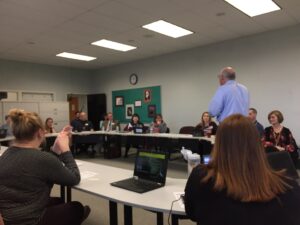Contributed by Judd R. Pittman, Special Consultant to the Secretary of Education for STEM, Pennsylvania Department of Education
ESSA, House Bill 833, Chapter 49 and School Code: these acronyms, bills, and phrases may mean little to some but are the “policy levers” that influence educational landscape in Pennsylvania for the foreseeable future. Wherever you are located, the educational climate is significantly impacted by policy decisions.

The everyday rhythms of educational leaders, teachers and students seem so distant from the policies that too often are brainstormed in the back rooms of government buildings and in the offices of state and/or federal education agencies. However, educational policies set the goals and boundaries for the experiences that play out in our schools every day.
Pennsylvania is no different from other states that are trying to disrupt the status quo by igniting the cross pollination between the practitioner, consumer and policy maker. STEM Learning Ecosystems provide a mechanism for every stakeholder to have an entry point into the STEM policy conversation.
- STEM Learning Ecosystems help to organize, facilitate and engage in stakeholder sessions that provide valuable feedback from the field for policy makers.
- STEM Learning Ecosystems leverage communications systems like blogs, social media, and traditional press to elevate implementation that represents exemplar practices and systems.
- STEM Learning Ecosystems energize and ignite cross sector stakeholders that act as a cohesive champion for educational policies that focus on equity and access for every learner to STEM.
Pennsylvania has five nationally recognized STEM Learning Ecosystems, four emerging and four fledgling systems looking to leverage a network approach to make STEM education a reality for every learner regardless of socio economic status, ethnicity, label and/or zip code. The five nationally recognized Ecosystems capture the uniqueness of Pennsylvania representing the urban, rural, and suburban nature of the over 500 locally-controlled districts in the Commonwealth. Complexities at the local, regional, and statewide level make attending to the educational challenges of each community difficult; however, educational policies should be crafted with this context at the forefront.
“What we measure is what we treasure” is a phrase often floated in educational circles. In Pennsylvania, the Every Student Succeeds Act (ESSA) provided the State Department of Education an opportunity to reimagine the variables used to highlight effective schools by broadening those points of review to include more holistic measures like career readiness, opportunities for dual enrollment and/or access to rigorous courses like Advanced Placement. ESSA also gave states the opportunity to emphasize the direction of education, for example elevating the importance of STEM education for every learner K-12.
In Pennsylvania, House Bill 833 was a policy written to enable local school districts to make decisions for allowing a computer science course to count for a math and/or a science graduation credit. House Bill 833 was signed by Governor Wolf in the summer of 2016 and led to a cascade of actions, including the implementation at the local level, the endorsement of computer science standards by the State Board of Education, and the exploration of computer science teacher certifications pathways. These actions resulted from the influence of stakeholders, most importantly those organized by the STEM Ecosystems.

Pennsylvania’s Ecosystems used the strategies mentioned to swim through the local and statewide complexities when generating, reviewing and/or considering changes to STEM educational policy like those outlined in ESSA and House Bill 833. Leading up to the ESSA Plan final submission, the STEM Ecosystems took full advantage of their networks by helping to hold stakeholder sessions on breadth and depth of STEM education in the regions and ignited a call to action during the ESSA Plan public comment period. The many stakeholder sessions gave thoughtful information to help guide the development of the plan while the call to action during public comment provided targeted feedback on Pennsylvania’s State Plan.
The strong networks of the STEM Learning Ecosystems helped the Pennsylvania State Department of Education identify some of the most influential and experienced stakeholders for a comprehensive Computer Science for All workgroup that provided intentional feedback on how to best operationalize House Bill 833. Additionally, the workgroup was able to give thoughtful feedback on standards and teacher certification pathways. Without the STEM Learning Ecosystem’s ability to energize, communicate, and organize, thoughtful policies and implementation would be more of a dream and less of a reality in Pennsylvania.
Learn more about Judd Pittman here.

